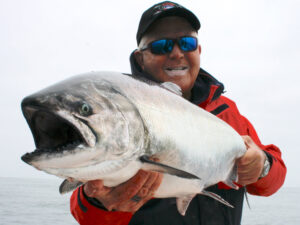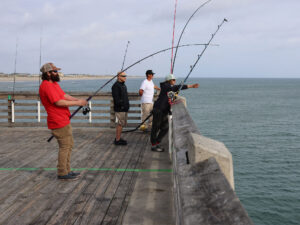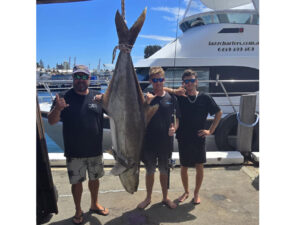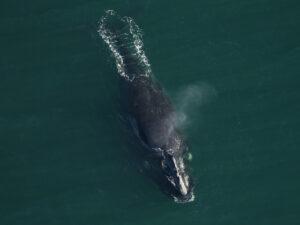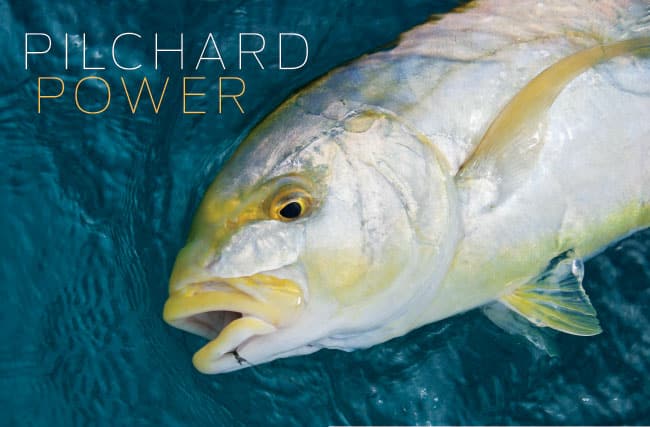
Pilchard Power
Some cooperative January weather made the 10-mile run to Western Dry Rocks an easy one. Western Dry Rocks is one of a series of shoals that stretches west from just off Key West to beyond the Marquesas, marking the ridge of reefs separating the 20- to 50-foot depths of Hawk’s Channel from the steep drop into the Atlantic.
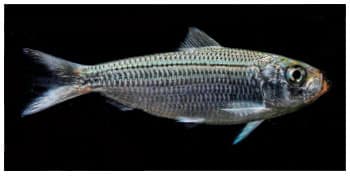
| |A livewell full of scaled sardines, aka pilchards, offers pretty good odds for fast action off Key West from a variety of light-tackle game fish. Yellow jacks are among the author’s favorites.|
The goal of the team from Quantum/Fin-Nor that had invited me down to try out some of its new gear was a pretty simple one: Catch fish. Lots of ’em, and different kinds. Anytime a day of fishing is likely to provide my two favorite aspects of the sport — fast action and good variety — I’m all over it, and all the more so when that action is combined with fairly light gear.
Species Suite
In that regard, activity did lead to more activity during the day, and our mission was accomplished. That probably wouldn’t have been the case without a) Trosset’s expertise at putting us where we would find the most fish, but also b) having plenty of live chum to stir things up.
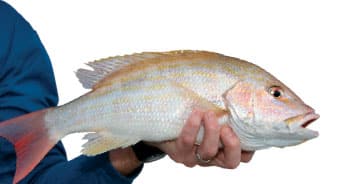
| |The variety seems endless; this lane snapper approaches trophy size for the species.|
Although it’s a short run from Key West Harbor, Western Dry Rocks offers plenty of structure around the reef crest. We fished spots along there from the Dry Rocks and west 15 miles or so to Cosgrove Shoal.
It didn’t take long for rods to start bending once Trosset (spindriftfishing.com, rtspindrift@aol.com, 305-797-5693) had anchored his 34-foot Yellowfin and began putting scent — via frozen chum blocks — in the water, followed by flash, in the form of handfuls of wriggling pilchards from the generous supply in the baitwell.
In two days, we ended up with a pretty respectable species list, including: yellow jacks (great nearshore game fish!), cero mackerel (a couple of impressive size), rock hinds, yellowtail snapper (fired-up enough even to grab my topwater plug), kingfish, little tunny, gag grouper, scamp, gray snapper, red grouper, lane snapper, black grouper, jack crevalle and goliath grouper. Although we didn’t happen to catch any mutton snapper, blackfin tuna or hogfish (for which live jumbo shrimp are the real ticket), they’re among a number of other species anglers commonly take in these waters.
If our success seemed easy, that was largely a reflection of Trosset’s 38 years as a Key West fishing guide. Most anglers don’t have that sort of experience, so I endeavored to pick the captain’s brain, in his occasional moments when not rigging up or releasing or boating a fish.
A Catch-All Bait
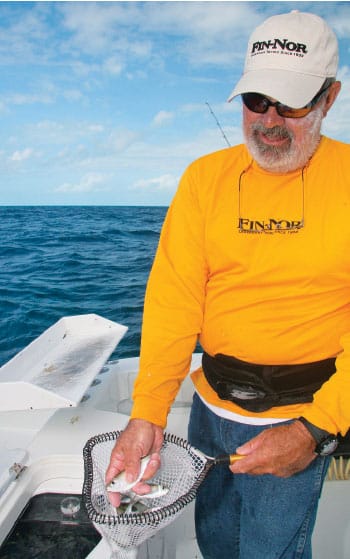
| |Live “white-bait” chumming around rocks and coral heads usually stirs things up in a hurry.|
What eats pilchards?
Easier question: What doesn’t?
“All game fish I know of eat pilchards,” Trosset says.
They’re most available around Key West from October into June, then harder to come by during the warmer months.
Although you get what you get when catching ’em, if you end up with various size options in your live well, Trosset suggests 4- to 6-inchers for sails, kings and wahoo and 2- to 4-inchers for blackfin, cero and other smaller predators.
That said, elephants do eat peanuts also: “During the years we were catching big yellowfin tuna here — 100- to 200-pounders — they’d be filled with small pilchards, but never large ones,” Trosset says.
Pilchards are the live bait of choice for almost everything. Reasonably hardy and abundant, pilchards are caught by Trosset both by cast-netting and by using sabiki rigs.
Pilchard Pointers
A great tip for finding them: Watch pelicans’ behavior after diving. “If pelicans leave their heads in the water after they hit the surface, they’re usually after glass minnows,“ Trosset says. “But if they pull their heads right out after diving, they’re eating pilchards. Saves a lot of time idling over the flats.”
Trosset often will utilize a bit of current to anchor and chum them in with frozen block chum or cat food mixed with whole-wheat bread. “Wait until the pilchards get thick,” he says. “You won’t have to throw as many times to fill your well.”
With No. 6 or No. 8 sabikis, you can catch pilchards around markers or underwater structure (in a few feet of water or as deep as 120 feet).
Trosset points out that a good baitwell will have plenty of circular, uninterrupted water flow: “Mine run 1,600 gallons per hour. My 65-gallon well holds 50 pounds of small pilchards; my 50-gallon well will hold 40 pounds of small pilchards — a little more than a five-gallon bucketful.” With large pilchards, he doesn’t pack his well nearly as full because bigger baits are more prone to overcrowding.
At the end of a fishing day, if many pilchards remain in the well, Trosset will close things out with a flurry of live-bait chumming (usually producing a flurry of activity), because leftover well baits don’t hold up reliably overnight, even in a bait pen.
Skyrocketing Grouper
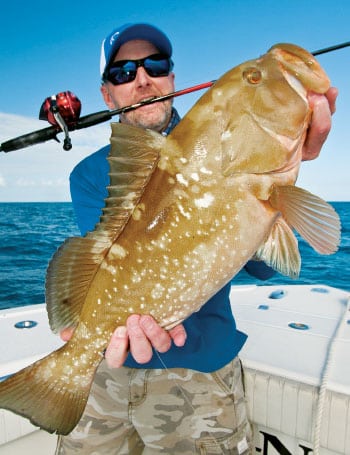
| |Think you’re good? Try catching a big red grouper on a Zebco push-button reel! Bob Bagby, with Fin-Nor and Quantum, proved his prowess.|
Other live baits, such as threadfins, certainly will do a good job too. And whenever ballyhoo offer the opportunity (notably October into February; watch for frigate birds over the reef), Trosset is delighted to cast-net or sabiki as many as he can.
In fact, for Trosset, ballyhoo don’t take a back seat to any other live bait. All sorts of large predators come in to the shallow reef top to prey on them. “In the 1970s and ’80s,” he recalls, “you could see 40- and 50-pound black grouper skyrocketing under schools of ballyhoo!”
One of Trosset’s favorite techniques calls for throwing plugs deep into schools of ballyhoo as they crowd the surface. He favors floating minnow plugs with the lips removed. “If the ’hoos are showering, and you can throw a plug into the shower, something will smash those plugs every time,” he says.
Trosset also points out that you can usually get a pretty good idea of the predator du jour by watching the ballyhoos’ frightened reaction. “If they blow up and disperse randomly [in all directions], it’s likely that grouper, snapper and jacks are after ’em. But if they all streak out in one direction, you can figure it’s a pelagic, such as a sailfish.”
Of course, speaking of pelagics, if they’re your target, you can’t do better than a live speedo (as redtail scads are commonly known). Unlike pilchards, however, speedos are not particularly hardy, and they often don’t endure very long in livewells.
Rigs and Strategies
The top of the reef tends to get traffic from both sides; that’s one of the reasons it offers up so much variety. Accordingly, Trosset likes to take advantage of all the opportunities by fishing the entire water column — the upper part, he says, for mackerel, bar (and yellow) jacks, blackfin tuna and sailfish. Even wahoo and dolphin sometimes show up in 20 or 30 feet of water atop the reef edge.
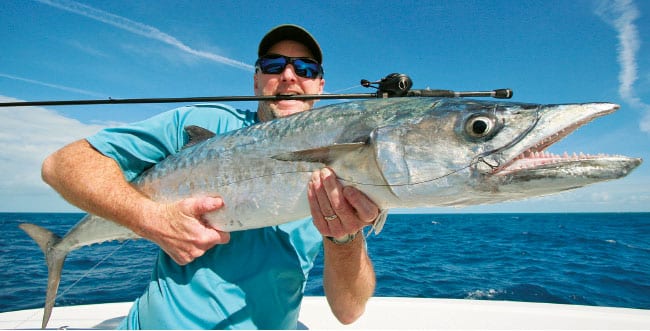
| |This time, Bagby tested the drag of Quantum’s new Smoke baitcasters with a whopping kingfish that couldn’t pass up a flylined pilchard.|
Trosset is a fan of free-drifting livies. For this, he favors nose-hooking pilchards (from the side) unless he wants the baits to swim down, in which case hooking through the belly is best. Trosset’s hooks of choice for this are 1/0 to 2/0 Wizard circles or 1/0 to 3/0 9175 Mustad circles.
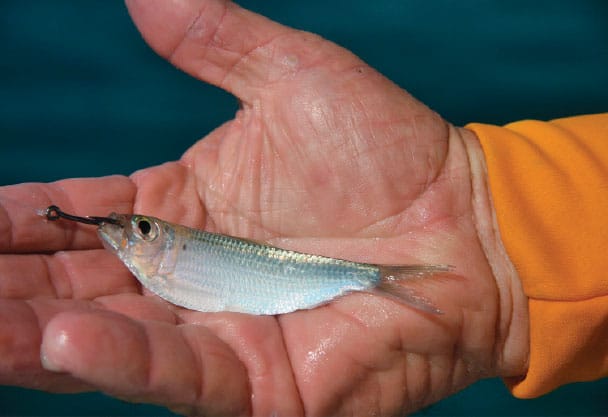
He recommends no drop-back for pilchards struck near the surface. “Leave the reel in gear, but don’t set the hook. Hold the rod tip toward the fish, and let the line come tight slowly,” as with any circle hook, he says.
To target grouper, snapper and other species typically inhabiting the lower part of the water column, Trosset favors a knocker rig — a half-ounce to 1½-ounce egg sinker rigged to slide on the leader with a 1/0 to 4/0 Wizard circle hook.
When non-toothy fish are the target, Trosset prefers 30- or 40-pound fluorocarbon leader. For kingfish or other mackerel, he’ll go with a 12- to 18-inch single-strand wire leader of 27- to 61-pound-test.
And keep a wire-straightener handy because single‑strand leaders tend to get a bit corkscrewed in use. “But,” the skipper advises, “don’t straighten a wire leader too many times, or it will get weak.” Before reaching that point, the leader should be replaced.
Trosset notes that there are plenty of times he leaves wire traces on; it isn’t always necessary to switch to fluorocarbon in hopes of catching blackfin or even sailfish. That is, if the fish are fired-up, a thin wire leader will not deter strikes. Trosset also prefers treble hooks when targeting mackerel, specifically No. 4 or No. 6 4X-strong VMCs.
Fire ’Em Up
Live chumming with pilchards is really the key to success, and it’s why Trosset tries to make sure he reaches the grounds with plenty of pilchards in the well. First thing, though: “Let your chum block work for 15 minutes or so,” he advises. “Then, start throwing four to 10 freebies every minute or two.” If that approach is working, you’ll know: You’ll see fish busting on the bait. When you begin seeing that, “Throw a little heavier,” Trosset says— since, well, activity begets activity!
Returning to the theme of everything eating pilchards, Trosset says: “We catch a lot of sails on them. Once sailfish get fired-up, they sort of lose their minds — they just go crazy!” Multiple hookups, anyone?
Trosset also advises anglers to be ready to throw topwater plugs or jigs when they see fish busting on live chum. If the casts come close to the commotion, odds are they’ll hook up.
In the heat of a good surface bite, though, don’t neglect putting a bait or two down deeper; larger grouper and mutton snapper often lurk just under the commotion they’ve come to investigate.
Finally, Trosset suggests keeping in mind that “no matter where your chum is going, the freebie pilchards will swim towards shore. Blind-cast toward where those pilchards should be swimming.”
Ultimately, of course, nothing — even a livewell full of frisky pilchards — guarantees fish here or anywhere.
Still, for action and variety in the productive waters off Key West, chumming and fishing live bait is about as close as you’ll get to a sure thing.
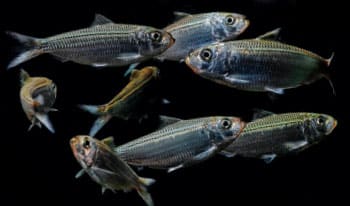
A Pilchard Primer
Although universally called pilchards in the Keys (and elsewhere), Harengula jaguana are properly known as scaled sardines. This important forage fish, a member of the herring family, is abundant along the Atlantic Coast from the mid‑Atlantic to Key West, throughout the Gulf and south to Brazil.
Unlike the similar thread herring, pilchards lack an elongate last ray on their dorsal fins. Pilchards feed on plankton and grow quickly. Individuals larger than 6 inches are rare.
Photo by Jason Arnold / jasonarnoldphoto.com

